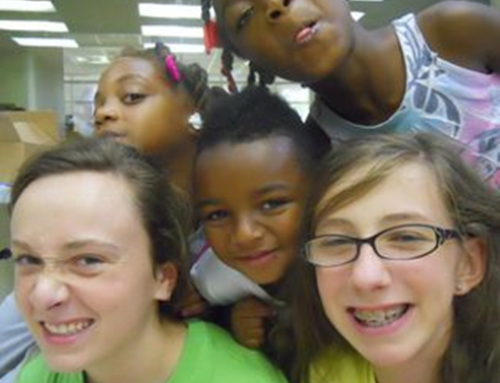More than 12 years ago, Kris and I felt led to start New Hope, to minister to under-resourced children and their families. We began our journey with more enthusiasm than wisdom.
Early on in our ministry, a mentor shared the “River Babies” story with me. His ministry was similar to ours, providing an after-school tutoring program for under-resourced children living on the northside of our town. I thought I understood the story’s meaning straightaway. Over the years, however, my own experiences have enabled me to see multiple layers of wisdom beneath the story’s surface. Now, I share the “River Babies” parable with you.
“Once upon a time, there was a small village on the edge of a river. Life in the village was busy. There were people growing food and people teaching the children to make blankets and people cooking meals.
One day as a villager took a break from harvesting, he noticed a baby floating down the river toward the village. She couldn’t believe her eyes! Almost immediately, she heard more crying in the distance. She looked further downstream to see that two babies had already floated by the village. She looked around at the other villagers working nearby.
“Does anyone else see this baby?” she asked.
One villager heard the woman, but continued working. “Yes!” yelled a man who had been making soup. “Oh, this is terrible!” A woman who had been building a campfire shouted, “Look, there are even more upstream!” Indeed, there were three more babies coming around the river bend.
“How long have these babies been floating by?” asked a villager. No one knew for sure, but some people thought they might have seen something in the river earlier. They were busy at the time and did not have time to investigate.
They quickly organized themselves to rescue the babies. Watchtowers were built on both sides of the shore and swimmers were coordinated to maintain shifts of rescue teams that maintained 24-hour surveillance of the river. Ziplines with baskets attached were stretched across the river to get even more babies to safety quickly.
The number of babies floating down the river only seemed to increase. The villagers built orphanages. They had their children make more blankets. They increased the amount of food they grew to keep the babies housed, warm and fed. Life in the village carried on.
One day, a villager continued to walk by, despite observing the rescue efforts going on. Those who had been working in the system to rescue the babies called to that villager and asked him to join their ranks. He declined.
One of the rescuers yelled, “Where are you going? There are so many people that need help here.” To which the man replied, “I’m going upstream to find out why so many babies are falling into the river.”
At first blush, some of the parable’s meaning is immediately apparent. There is some social ill that is harming children that requires the village’s intervention. Yet, the deeper we delve into the story, the richer its meaning becomes.
Another insight this story offers is that unless there is an ardent champion, most villagers will not break out of the rhythm of their daily routines. They continue to make soup and build campfires. They are focused on their own tasks and responsibilities. The cries of the hurting become ambient noise in the background that can easily be ignored. Although most villagers are aware that something is wrong, it takes a champion to bring attention to the babies’ plight.
The River Baby parable also demonstrates that the urgency of the immediate need can be so great that we never stop to ponder the problem’s cause. If the problem’s source is not addressed, the problem will certainly continue and likely worsen. The villagers in our story were being inundated with River Babies.
My mentor shared this story with me with this insight: by working with children, we are working upstream! When we started New Hope, I was convinced that prison ministry, helping the homeless, and recovery programs were downstream ministries. By working with children, we were addressing profound social problems before they got started.
We began New Hope with a Frederick Douglass aphorism in mind: “It is easier to build strong children than to fix broken men.” Starting with the children intuitively makes sense. Thus, we felt that we were among the few enlightened upstream ministries.
I imagine that almost everyone involved in a ministry to the poor believes that their particular ministry is “THE” ministry. The reality is that all ministries to the under-resourced are important. We all have unique gifts, passions and experiences that make us better suited for some things than for others. A particular ministry is not better than another: it’s better suited for you. We need them all. Since many River Babies have floated past us, we need “downstream” ministries too.
I thought by establishing a program to help under-resourced children, we were upstream. Ironically, a decade later, as the babies continued to come at an even more rapid pace, I realized that we too were merely pulling children out of the water, just like the villagers in our parable.
I wasn’t as far upstream as I had thought.
Over time, I began to understand that many of the ministries that I considered downstream, actually had a significant upstream impact. For example, those who are incarcerated, homeless, or wrestling with addictions often have children. Homelessness is not just an adult problem. There are over two-hundred homeless children in the Lafayette Parish School System.
At New Hope, we have had children in our program that were living in shelters for battered women. So, in a very real way, ministries that minister to parents also indirectly minister to their children in significant ways.
These “downstream” ministries were further upstream than I had thought.
Another thing I have learned along the way is that the entire idea of going upstream is a bit of a misnomer. There is not just one source for this river. The further you go upstream, the more you realize that this river has many tributaries. Many issues contribute to our River-Baby problem, and all of them are important.
We often think of the mighty Mississippi as one long river, but actually many rivers flow into it, like the Arkansas, Missouri and the Ohio rivers. These rivers, in turn, have their own branches that flow into them. The Tennessee, the Cumberland, and the Allegheny Rivers all flow into the Ohio. Just as there is no single source for the Mississippi River, there is no single source for our River Baby dilemma. There is a network of intertwined social problems that put our babies in the river. Like a river system, everything is connected, with each issue impacting the next.
Lack of adequate affordable housing, neighborhood violence, substance abuse, poverty, joblessness, and single-parent households are not the problems. They are River-Baby tributaries that need to be explored.
The things we typically identify as problems are merely symptoms of deeper problems. When we think we have identified the problem, we need to go further upstream by asking the question, “Why are things like this?”
Yes, we need to rescue these new babies, but at the same time we also need to keep pushing upstream. Like a four-year-old child, we need to keep asking the question, “But why?”
With starting a ministry to under-resourced children, I thought we had found the upstream solution. Now I realize that we are just one of many ministries needed to help vulnerable children and their families.
There is no silver bullet.
There are many ministries, each doing their own part.
Still, an obvious question remains: Why are there so many babies in the river? Why do we have so many at-risk children in our community? Why has the need for after-school tutoring programs and mentoring programs grown? Why has juvenile crime and violence increased across the country? To answer these questions, we need to go upstream.
Many blame our River-Baby problem on our public schools. If only things were so simple! Simple solutions are often offered by those who have not explored many tributaries. They see what they see at their downstream location, but have never asked “Why?” They have confused what they see as being the cause of what they see. That is because they haven’t seen anything else. They have no idea what is happening upstream.
Yes, it is true that high-poverty public schools have a high percentage of high-school dropouts. In Lafayette, the graduation rate of Northside High School is only 55%, but that isn’t the problem. It is a symptom.
It is not a question about our public-school performance. The question is rather, why are there such academic disparities based on race and income? Why is there an income and racial academic achievement gap of approximately two grade levels? Why hasn’t this gap narrowed in more than 40 years? Why do these same income and racial achievement gaps exist in private schools and charter schools? Why is the racial achievement gap larger than the income achievement gap?
If we don’t ask these questions, we will never discover that Social Economic Status (SES) is the single-most correlated factor to academic performance. No other factor even comes close. As a family’s SES goes up, a child’s academic performance goes up. Family income matters much more than whether a school is public, private school, or charter. In fact, often under-resourced children do modestly better in public schools.
Furthermore, the US public education system actually does quite well in terms of educating middle-class children. Even in Lafayette, La., white middle-class children attending our public schools, on average, are a half-a-grade level above their peers nationally. When the SES of US students is taken into account, the US educational system is among the top seven in the world.
The United States is also one of the best nations in educating the poor. There are only two or three nations that do a better job in educating under-resourced children. The US’s issue is that our child poverty rate is much higher than the rest of the industrialized world.
The US child poverty rate is four times that of Scandinavian countries; and two to three times that of Canada, Australia, and Western Europe. Nationally, our child poverty rate is higher than 20%. We don’t have an education problem: we have a child poverty problem.
When we misdiagnose a problem, not only do we not fix the problem, we make it worse. Because the “No Child Left Behind” and “Every Child Succeeds Act” misdiagnosed the education problem, the federal government actually takes away funding from high-poverty schools and punishes teachers in those schools. These schools need more resources, not less. We need to encourage teachers to enter these difficult environments; not blame them for it.
Poverty too is a symptom, not the problem. Seeing poverty as the ultimate problem is as harmful as blaming the high-poverty public schools for their poor academic outcomes.
Poverty, however, is a major tributary that needs to be explored. We need to ask, “How does poverty affect children?” “Why are there so many single-parent homes in poor neighborhoods?” “Why does the United States have such a high child poverty rate?”
As we explore these questions, we will often find that the answers are not what we thought. If we remain standing at the mouth of the river and that is all we see, we will remain unaware of all that happens upstream. We will never understand how our babies got into the river. As we go upstream, we discover a vast network of tributaries, all of which contribute to the problem.
So, we need to continue going upstream. Settling for quick and easy answers is the enemy of finding real solutions.
Over the last 12 years, we had thought we had finally arrived “upstream” several times, only to discover the issues were farther upstream, yet still.
I want to invite you on a journey upstream with me. I don’t claim to have things figured out, but I am further upstream than I was 12 years ago. Hopefully, in another 12 years, I will be further upstream than I am today.
Everything is connected. Ministries to under-resourced children are important. Every ministry to juveniles, parents and adults are important. Each ministry positively impacts our kids. Yet, while it is vital to rescue the babies today, it is even more vital that we stop putting babies in the water. So, come, join me upstream, and let’s find out where all those babies are coming from.





